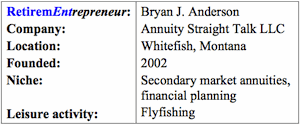
Reel Returns
Native Montanan Bryan Anderson, founder of AnnuityStraightTalk.com, is the second subject in our series on 'RetiremEntrepreneurs.' Flyfishing here (right) with a client, he's helping make secondary market annuities a 'mainstream' product.


